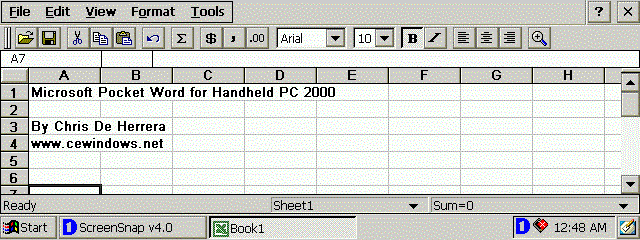Pocket Excel Download Windows Ce 50

Windows Mobile 6.5.3 screenshot Working state Succeeded by Initial release April 19, 2000; 18 years ago ( 2000-04-19) 6.5.3 / February 2, 2010; 9 years ago ( 2010-02-02) 6.5.5 Marketing target Update method type Default licensed to Preceded by and Succeeded by Official website Windows Mobile is a discontinued family of developed by for. Its origin dated back to in 1996, though Windows Mobile itself first appeared in 2000 as PocketPC 2000. It was renamed 'Windows Mobile' in 2003, at which point it came in several versions (similar to the desktop versions of Windows) and was aimed at business and enterprise consumers.
Microsoft Office mobile apps are productivity mobile apps currently developed by Microsoft for. Originally released as Pocket Office on Windows CE v1.0 Handheld PCs in 1996, they were ported to Windows Mobile. It consisted of Pocket Word and Pocket Excel; PowerPoint, Access, and Outlook were added later. With WinCE's Pocket Office applications, information can be easily entered. A software developer's kit — available for free download from 3Com's Web. Net access is limited: Users get 50KB of transfers for $9.95 per month. And Pocket Excel can be translated automatically into the Office 97/Windows 2000 format.
It became one of the most popular mobile operating systems as of the mid-2000s, but its popularity faded rapidly in the following years, and by February 2010, facing competition from rival mobile OSs, including Apple's and, Microsoft announced to supersede Windows Mobile. As a result, Windows Mobile has been. Windows Phone is incompatible with Windows Mobile devices and software. The last version of Windows Mobile, released after the announcement of Windows Phone, was 6.5.5. After this, Microsoft ceased development on Windows Mobile, in order to concentrate on Windows Phone. Contents • • • • • • • • • • • • • • • • • • • • • Features [ ] Most versions of Windows Mobile have a standard set of features, such as and the ability to navigate a file system similar to that of and, including support for many of the same file types. Similarly to its, it comes bundled with a set of applications that perform basic tasks.
Is the default, and is the default used for playing. The mobile version of, is the default., supported on compatible devices, allows the phone to share its Internet connection with computers via USB and Bluetooth. Windows Mobile supports over protocol. Most devices with mobile connectivity also have a.

The Radio Interface Layer provides the system interface between the Cell Core layer within the Windows Mobile OS and the radio protocol stack used by the wireless modem hardware. This allows OEMs to integrate a variety of modems into their equipment.
The user interface changed dramatically between versions, only retaining similar functionality. The Today Screen, later called the Home Screen, shows the current, owner information, upcoming appointments, e-mails,.
The taskbar display the current time as well as the volume level. Devices with a cellular radio also show the signal strength on said taskbar.
An Alpha build of WinPad in the early days of development showing off stylus compatibility Windows Mobile is based on the and first appeared as the Pocket PC 2000 operating system. It includes a suite of basic applications developed with the Microsoft, and is designed to have features and appearance somewhat similar to versions of. It allowed to for Windows Mobile with no restrictions imposed by Microsoft. Software applications were purchasable from during the service's lifespan. Most early Windows Mobile devices came with a, which can be used to enter commands by tapping it on the screen.
The primary touch input technology behind most devices were which often required a stylus for input. Later devices used which does not require a stylus. Along with touchscreens, a large variety of existed for the platform.
Some devices featured slideout keyboards, while others featured minimal face buttons. Windows CE [ ]. Main article: Microsoft's work on handheld portable devices began with research projects in 1990, with the work on Windows CE beginning in 1992. Initially, the OS and the user interface were developed separately. With Windows CE being based on Windows 95 code and a separate team handing the user interface which was codenamed WinPad (later Microsoft At Work for Handhelds). Windows 95 had strong pen support making porting easy; with some saying 'At this time, Windows 95 offers outstanding pen support. Buku psikologi perkembangan pdf.
It is treating pens right for the first time.' WinPad was delayed due to price and performance issues, before being scrapped in early 1995 due to touchscreen driver problems relating to WriteTouch technology, made by NCR Microelectronic Products. Although WinPad was never released as a consumer product, Alpha builds were released showcasing many interface elements. During development of WinPad a separate team worked on a project called Pulsar; designed to be a mobile communications version of WinPad, described as a 'pager on Steroids'. This project was also canceled around the same time as WinPad. The two disbanded groups would form the Pegasus project in 1995. Pegasus would work on the hardware side of the Windows CE OS, attempting to create a form factor similar to a PC-esque PDA like WinPad, with communications functionality like Pulsar.